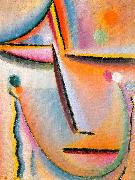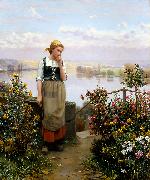
Oil On
Canvas, Real Flavor of Old Masters
|
Alexei Jawlensky
|
|||
|
|
|||
| 1864-1941 Russian Alexei Jawlensky Galleries Alexej von Jawlensky was born in Torzhok, a town in the department of Tver, Russia, as the fifth child of Georgi von Jawlensky and his wife Alexandra (n??e Medwedewa). His family was aristocratic. At the age of ten he moved with his family to Moscow. After a few years of military training, he became interested in painting, visiting the Moscow World Exposition c. in 1880. In 1896 he moved to Munich where he studied in the private school of Anton Azbe. In Munich he met Wassily Kandinsky, and Marianne von Werefkin, other Russian artists and helped form the Neue Kunstlervereinigung M??nchen. His work in this period was lush and richly coloured, but later moved towards abstraction with a simplified and formulaic style in a search to find the spiritual. Alexej von Jawlensky. Abstract Head, c. 1928He died in Wiesbaden, Germany on 15 March 1941. | |||
|
|
|||
|
|
Meditation Alexei Jawlensky4.jpg Painting ID:: 2063 Visit European Gallery |
1922 Lenbachhaus, Munich | |
Height Width |
INS/CM |
||
|
X |
|
||
|
|
|||
|
Atkinson Grimshaw
|
|||
|
|
|||
| British 1836-1893 Atkinson Grimshaw Gallery Grimshaw's primary influence was the Pre-Raphaelites. True to the Pre-Raphaelite style, he put forth landscapes of accurate color and lighting, and vivid detail. He often painted landscapes that typified seasons or a type of weather; city and suburban street scenes and moonlit views of the docks in London, Leeds, Liverpool, and Glasgow also figured largely in his art. By applying his skill in lighting effects, and unusually careful attention to detail, he was often capable of intricately describing a scene, while strongly conveying its mood. His "paintings of dampened gas-lit streets and misty waterfronts conveyed an eerie warmth as well as alienation in the urban scene." Dulce Domum (1855), on whose reverse Grimshaw wrote, "mostly painted under great difficulties," captures the music portrayed in the piano player, entices the eye to meander through the richly decorated room, and to consider the still and silent young lady who is meanwhile listening. Grimshaw painted more interior scenes, especially in the 1870s, when he worked until the influence of James Tissot and the Aesthetic Movement. On Hampstead Hill is considered one of Grimshaw's finest, exemplifying his skill with a variety of light sources, in capturing the mood of the passing of twilight into the onset of night. In his later career this use of twilight, and urban scenes under yellow light were highly popular, especially with his middle-class patrons. His later work included imagined scenes from the Greek and Roman empires, and he also painted literary subjects from Longfellow and Tennyson ?? pictures including Elaine and The Lady of Shalott. (Grimshaw named all of his children after characters in Tennyson's poems.) In the 1880s, Grimshaw maintained a London studio in Chelsea, not far from the comparable facility of James Abbott McNeill Whistler. After visiting Grimshaw, Whistler remarked that "I considered myself the inventor of Nocturnes until I saw Grimmy's moonlit pictures."[9] Unlike Whistler's Impressionistic night scenes, however, Grimshaw worked in a realistic vein: "sharply focused, almost photographic," his pictures innovated in applying the tradition of rural moonlight images to the Victorian city, recording "the rain and mist, the puddles and smoky fog of late Victorian industrial England with great poetry." Some artists of Grimshaw's period, both famous and obscure, generated rich documentary records; Vincent Van Gogh and James Smetham are good examples. Others, like Edward Pritchett, left nothing. Grimshaw left behind him no letters, journals, or papers; scholars and critics have little material on which to base their understanding of his life and career. Grimshaw died 13 October 1893, and is buried in Woodhouse cemetery, Leeds. His reputation rested, and his legacy is probably based on, his townscapes. The second half of the twentieth century saw a major revival of interest in Grimshaw's work, with several important exhibits of his canon. | |||
|
|
|||
|
|
Meditation new16/Atkinson Grimshaw-787796.jpg Painting ID:: 44635 Visit European Gallery |
mk174 ca.1875 Oil on canvas | |
Height Width |
INS/CM |
||
|
X |
|
||
|
|
|||
|
RAFFAELLO Sanzio
|
|||
|
|
|||
| Italian High Renaissance Painter, 1483-1520 Italian painter and architect. As a member of Perugino's workshop, he established his mastery by 17 and began receiving important commissions. In 1504 he moved to Florence, where he executed many of his famous Madonnas; his unity of composition and suppression of inessentials is evident in The Madonna of the Goldfinch (c. 1506). Though influenced by Leonardo da Vinci's chiaroscuro and sfumato, his figure types were his own creation, with round, gentle faces that reveal human sentiments raised to a sublime serenity. In 1508 he was summoned to Rome to decorate a suite of papal chambers in the Vatican. The frescoes in the Stanza della Segnatura are probably his greatest work; the most famous, The School of Athens (1510 C 11), is a complex and magnificently ordered allegory of secular knowledge showing Greek philosophers in an architectural setting. The Madonnas he painted in Rome show him turning away from his earlier work's serenity to emphasize movement and grandeur, partly under Michelangelo's High Renaissance influence. The Sistine Madonna (1513) shows the richness of colour and new boldness of compositional invention typical of his Roman period. He became the most important portraitist in Rome, designed 10 large tapestries to hang in the Sistine Chapel, designed a church and a chapel, assumed the direction of work on St. Peter's Basilica at the death of Donato Bramante, | |||
|
|
|||
|
|
Meditation new20/RAFFAELLO Sanzio-777225.jpg Painting ID:: 55659 Visit European Gallery |
mk243 1508 120x105cm | |
Height Width |
INS/CM |
||
|
X |
|
||
|
|
|||
|
Daniel Ridgeway Knight
|
|||
|
|
|||
| 1839-1924 Daniel Ridgeway Knight Gallery Daniel Ridgway Knight was born on March 15,1839 in Pennsylvania. He studied and exhibited at the Pennsylvania Academy of the Fine Arts, were he was a classmate of Mary Cassatt and Thomas Eakins. In 1861, he went to Paris to study at L'Ecole des Beaux-Arts under Cabanel, and to apprentice in the atelier of Charles-Gabriel-Gleyere. | |||
|
|
|||
|
|
Meditation new20/Daniel Ridgeway Knight-274675.jpg Painting ID:: 57498 Visit European Gallery |
oil on canvas. | |
Height Width |
INS/CM |
||
|
X |
|
||
|
|
|||










